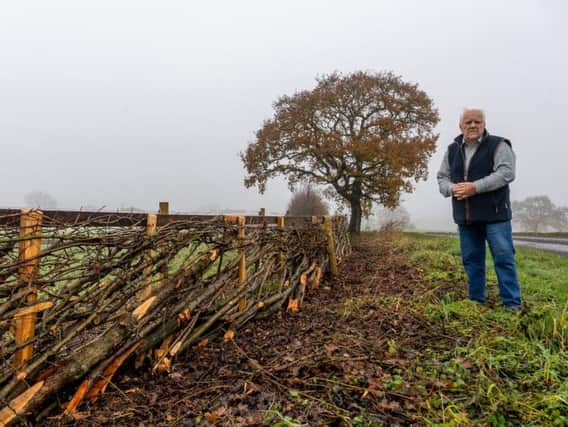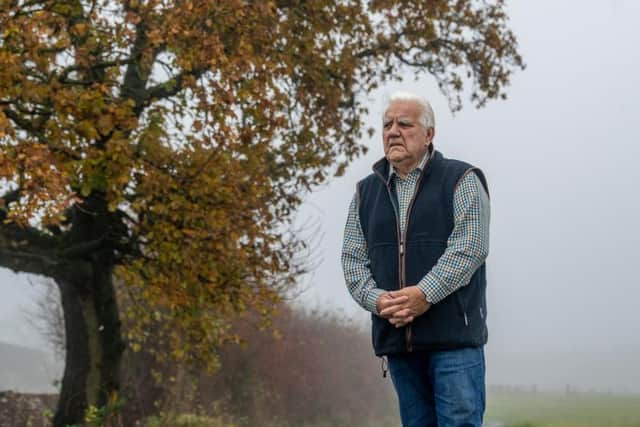Hedgelaying champion recalls the time The Yorkshire Post got him into trouble at school after triumph


Ken Walmsley, of The Old Stables at Risplith, near Ripon, recalls how his first brush with fame in the mid-50s at a hedgelaying day in Sheffield saw him somewhat exposed at school a few days later.
"I was only 12 years old and I took time off school on the Friday to enter this competition where my dad and my brothers also took part. Dad was in the open class and two of my brothers were in the novice class. I won the competition.
Advertisement
Hide AdAdvertisement
Hide Ad"It was great, but when I went in to school on the Monday saying I’d been ill on Friday, the reason I gave for not being there, my teacher said: ‘That’s funny Ken because there’s a photograph of you winning a hedgelaying competition in the Yorkshire Post.’


"Dad farmed at Pannal, where I was born in 1943. He had no tractors when I was a lad, he had Shire horses. He’d plough with them and I used to drive them, leading muck from a cart on the back. I have always enjoyed the craft of hedgelaying and the competitive side of it too.
Although the days when many farmers and farmers’ sons used to take part religiously every weekend now appear to have gone Ken tells of its continued presence in the rural calendar.
Emotional tribute to farmer who 'lived like he'd die tomorrrow and farmed like he'd live forever'Rural lobby group writes to every candidate in General Election to help fulfil "huge potential" of the countryside"Back when I was a lad most villages such as Pannaland Killinghall held hedgelaying competitions. It was the same all around the UK. There is still a thriving national championship. I’ve run the Yorkshire hedgelaying competition for 12 years. I won it quite a few times but these days I concern myself with making sure it takes place and the judging.
Advertisement
Hide AdAdvertisement
Hide Ad"The first thing I look for is straightness of hedge, how the competitor has laid it. They have to lay around nine yards and I’m particularly looking at what we call the liggers.
"They lay on top of each other to form the basis of the hedge. Every county has a different style. You put stakes and rails on the Yorkshire type, which is a very narrow hedge designed to promote growth out of the bottom.’
"You’re not allowed to use any deadwood either. The Yorkshire hedge is mainly made from quickthorn that grows straight. The main reason for hedges, as well as providing field boundaries, is to provide habitat for birds and wildlife, everything from hedge sparrows to hedgehogs.’
"Before a hedge is laid it will have gaps in it, but when laid properly it becomes a solid hedge that provides protection for habitat. From planting a hedge to laying it will be about 8-10 years. In that time it will have grown to around 8-10 feet high. I looked at a hedge in Ripley yesterday that was panted 10 years ago and it is now ready for laying, which assists in growth. Once you’ve laid a hedge it doesn’t want touching for another 2-3 years.’
Advertisement
Hide AdAdvertisement
Hide Ad"Hedgelaying as a sport is highly competitive. We get a lot of tree surgeons. It is something they can do in between the felling of trees. We had half a dozen out of the 20 who took part in the Yorkshire championships at Lindrick Farm near Ripon a fortnight ago.
Former cashier at Castle Howard ordered to pay back £78,000 after stealing from bossesYorkshire dairy farm deny they are the source of E.coli outbreak and continue delivering milk to customers"Competitions take part from October to March. The season is over as soon as there is a bud or leaves come back on the hedges as the sap starts to rise."
Such is Ken’s name in the hedgelaying world he still gets enquiries every week asking whether he can give a price for a hedge. He’s more than happy to pass on the work to the ones he knows will do a good job – and he’s keen to keep promoting the country sport to others.
"All hedgelayers bring their own tools – axes, saws, chainsaws and appropriate safety equipment and clothing. I provide the stakes, rails and everything else. We used to run a young farmers class and we no doubt would again if the young farmers clubs showed an interest.
Advertisement
Hide AdAdvertisement
Hide Ad"We run a junior class where we also have a helper, and there is also a novice class, so really anyone can come along and see what it’s about. We’d really like to see new people getting involved whatever your age."
Ken initially followed his father into farming by working on a farm in Harewood but building work lured him with greater possible riches even from the start.
"My pals were all builders and while I was earning £2 10s a week on the farm they were earning £10-£20 a week building so I took it on as my trade. I’ve been in it ever since starting as an apprentice with Fowlers in Harrogate. At 18 I started on my own and I developed a business in putting up houses for farmers who were retiring."
Whether he’s been hedgelaying or putting up houses it’s all been about construction for Ken.